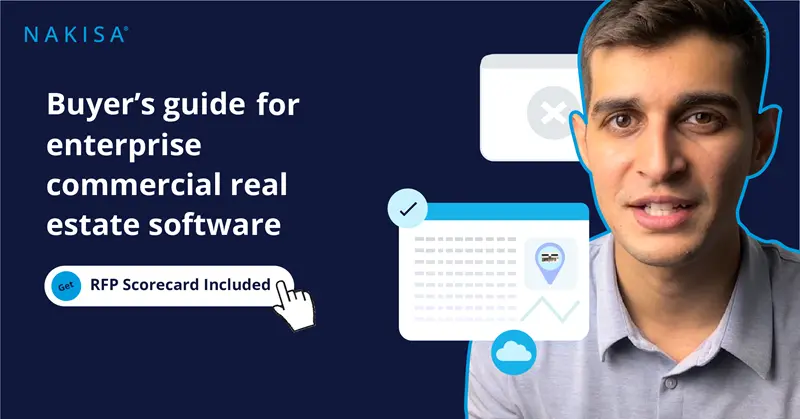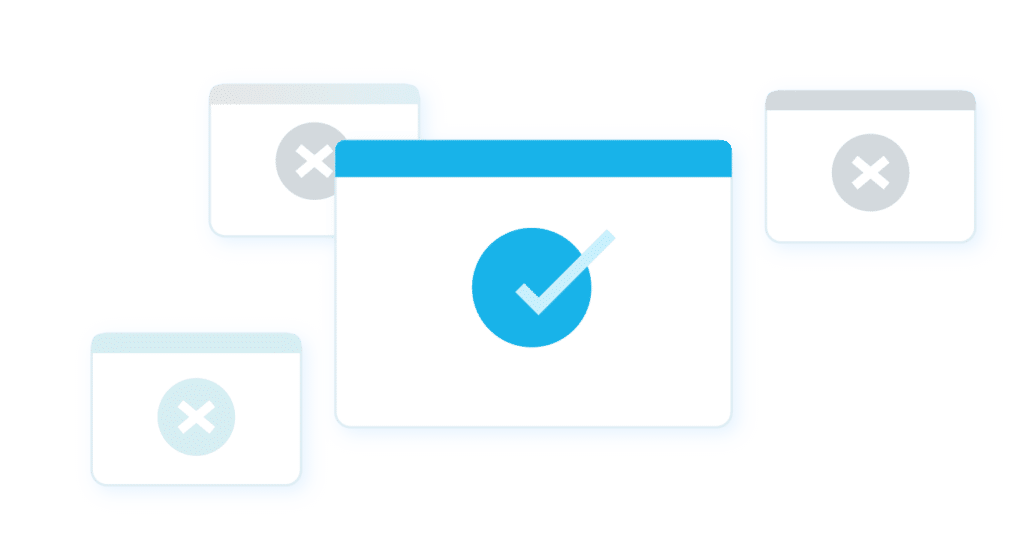
What You'll Learn
This comprehensive buyer's guide will assist you in finding the ideal commercial real estate management (CRE) software for your business. By following this guide, you will learn how to accurately define your solution needs, identify must-have software features, compare existing real estate management software, and explore industry trends.
Why trust this guide? Nakisa, a trusted name in the Commercial Real Estate industry, brings unparalleled expertise to this guide. With extensive industry experience and understanding of RE professionals' pain points, we are uniquely positioned to assist you in selecting the optimal solution tailored to your unique needs.
As a bonus, we have included our tried and tested vendor selection scorecard in this guide. This invaluable resource goes beyond mere recommendations—it presents a set of evaluation criteria used by some of the Fortune 500 companies accompanied by weighted scoring, enabling you to distinguish between merely desirable features and essential for your business.
Armed with this guide and scorecard, you can make informed purchasing decisions that will drive your real estate business management forward. So, let's find the solution to propel your real estate management to new heights!

Step 1 - Defining Your Software Needs
In Step 1 of this guide, we will define your software needs precisely. Understanding your specific needs and requirements is crucial when selecting the right software solution for your real estate business. This process lays the groundwork upon which you will base your purchasing decision.
Below are 3 main criteria to consider when articulating your business requirements. Each criterion is accompanied by a set of self-reflective questions to help you better understand your needs and pain points.
1A - Assess Your Current Processes and Challenges:
To begin, we strongly advise conducting a comprehensive evaluation of your pain points, challenges, and growth aspirations. Doing so will give you a deep understanding of your organization's unique requirements. Let's start by asking yourself the following questions.
- Real Estate Portfolio Management Challenges: What are my real estate operations' critical pain points, inefficiencies, and bottlenecks? (i.e., data consolidation and accuracy, manual workloads, complex multi-asset calculations, ad-hoc dashboard reporting, vendor payments, critical clause and date management) and what functionalities do I need to address these issues?
- Accounting Compliance and Reporting: What financial reports do I need to run my commercial real estate operations effectively? (i.e., CPI indexation, Cash flow, Occupancy and AP/AR payment financial report.) And what accounting standards do I need to comply with? (i.e., ASC 842, IFRS 16, GASB 87 and AASB 16 )
- Integration Capabilities: How important is interoperability to me? Do I require seamless bidirectional integration with other systems such as ERP (SAP and Oracle etc.) or POS systems to streamline data flow and eliminate manual data entry?
1B - Consider Scalability and Security
After addressing your pain points and organizational requirements, it is essential to consider your organization's security and growth aspirations. It is vital to guarantee that your chosen solution can accommodate your current and future security and scalability requirements. Ask yourself the following questions:
- Scalability: Are we planning to grow our real estate portfolio to enter new markets, countries, industries, or sectors? If so, will my software need to accommodate new compliance standards, increased transaction volumes and complex lease structures?
- Security: Will my solution need to support essential security protocols such as end-to-end data encryption, GDPR, and SOC 1 Type 2 & SOC 2 Type 2 compliance certifications? And does the solution vendor carry out a complete risk assessment audit on its solution?
- Complexity: Do I require advanced features such as multi-currency and multi-language support to operate in a global context? And do I need to automate and facilitate my percentage sales rent calculation, or common area maintenance (CAM) management?
1C - Define Implementation and Logistics Requirements:
Once you have assessed your pain points and growth projections, it's time to think about critical topics such as key stakeholders involved, project timeline and budget. Ask yourself the following questions:
- Implementation Timeline: What is my company's expected timeline for implementing the new solution? Do we have any critical deadlines or project milestones to meet? Who is the primary point of contact during the implementation?
- Data Migration: Do I have existing data that needs to be migrated to the new software? How will the vendor support this process, ensuring data integrity and accuracy? And how much will my vendor charge for the migration of my data?
- Training and Support: What training and support will my team require during implementation and beyond? Does my team need on-site training, user manuals, or access to a support helpline? Do we need access to publicly available training videos and product demos?

Step 2 - 5 Key Elements to Look for in a Real Estate Software
Now that you understand your pain points and growth requirements, the next step is to select the right solution for your enterprise. This task can be particularly challenging when aiming to satisfy the expectations of multiple stakeholders, including executives, Real Estate, Business Development, Finance, and IT teams.
At Nakisa, we have your back. We have worked with many large enterprises with 500+ lease contracts to implement real estate management solutions. As a result, we have developed a tried and tested weighted vendor scorecard to help you identify key features such as security deposit handling, sales forecasting, invoice and deadline management and the centralization of lease contract details.
Besides these mentioned features, below are five software features from our scorecard that we at Nakisa consider most noteworthy. These features will serve as valuable guidelines to help you choose the most suitable solution for your organization.
2A – Automated Tasks, Calculations, and Payments:
An effective solution should be able to automate and enhance your lease management workflow. It should support functionalities such as mass contract uploads and contract amendments such as lease terminations, expirations, and renewals. While also allowing you to automate rent calculations and payment generation (i.e., rent roll, percentage-based rent, batch payments and CPI rent calculations).
2B - Financial Reporting and Data Analytics:A good solution should have robust financial reporting capabilities to track revenue, expenses, and profitability across your real estate holdings. Examples of such reports include cash flow, tax, insurance, occupancy, and AP/AR reports. Additionally, the software should also allow you to slice and dice your data, choose custom parameters, and set up your own custom reporting dashboards.
2C - Integration Capabilities:
When applications work independently, they can create chaos. In order to get the most value from your SaaS applications, seamless integration and interoperability are key. As a result, to ensure data consistency, we recommend that your software have a bidirectional integration with robust ERPs such as SAP and Oracle.
2D - Accounting Compliance Capabilities:
In today’s highly regulated global environment, having a solution compliant with several accounting standards is critical. With this functionality, your lease management journey will become smooth. We recommend ensuring your software can support all the following fundamental accounting standards ASC 842, IFRS 16, GASB 87 and AASB 16.
2E - Cloud Nativity:
To ensure you stay ahead of the curve, we recommend your solution be built on the cloud native computing foundation. Cloud-native solutions are architected as collections of independent, loosely coupled microservices. They are built in a way that enables them to take better advantage of cloud computing models to increase software speed, flexibility, security, and quality while reducing deployment risks.
- 2A – Automated Tasks, Calculations, and Payments: An effective solution should be able to automate and enhance your lease management workflow. It should support functionalities such as mass contract uploads and contract amendments such as lease terminations, expirations, and renewals. While also allowing you to automate rent calculations and payment generation (i.e., rent roll, percentage-based rent, batch payments and CPI rent calculations).
- 2B - Financial Reporting and Data Analytics: A good solution should have robust financial reporting capabilities to track revenue, expenses, and profitability across your real estate holdings. Examples of such reports include cash flow, tax, insurance, occupancy, and AP/AR reports. Additionally, the software should also allow you to slice and dice your data, choose custom parameters, and set up your own custom reporting dashboards.
- 2C - Integration Capabilities: When applications work independently, they can create chaos. In order to get the most value from your SaaS applications, seamless integration and interoperability are key. As a result, to ensure data consistency, we recommend that your software have a bidirectional integration with robust ERPs such as SAP and Oracle.
- 2D - Accounting Compliance Capabilities:In today's highly regulated global environment, having a solution compliant with several accounting standards is critical. With this functionality, your lease management journey will become smooth. We recommend ensuring your software can support all the following fundamental accounting standards ASC 842, IFRS 16, GASB 87 and AASB 16.
- 2E - Cloud Nativity: To ensure you stay ahead of the curve, we recommend your solution be built on the cloud native computing foundation. Cloud-native solutions are architected as collections of independent, loosely coupled microservices. They are built in a way that enables them to take better advantage of cloud computing models to increase software speed, flexibility, security, and quality while reducing deployment risks.
These five essential features are indispensable for a comprehensive real estate management software. We encourage you to download our vendor scorecard to gain a more granular understanding of all the features we recommend.
Step 3 -Selecting the Right Software
In this last step, you will use the insights gained from the previous steps to decide which vendor you want to proceed with. Of course, you will want to choose the vendor ranked the highest on the scorecard. But you must also consider all the non-feature elements, such as vendor reputation.
To get an unbiased look into a company's reputation, you can check out platforms such as Capterra and Software Advice. These platforms offer customers like yourself a glimpse into what it's like working with a particular solution.
Additionally, it is recommended to dive deeper into the vendor's provided resources. Take the time to read case studies, solution briefs and eBooks provided by the vendor. These resources can provide you with a wealth of information about the vendor's expertise, successful implementations, and the value they bring to their customers.
It is also beneficial to take advantage of free product demos provided by the vendor. This allows you to experience the software firsthand and assess its usability, intuitiveness, and alignment with your organization's workflow and processes. Lastly, it's worth visiting the vendor's customer portal and familiarizing yourself with their product roadmap by reading documents such as their latest release notes.
Ultimately, choosing the right solution is a balancing act between features, outcome, value, and pricing, and it is a challenging game. Remember that the vendor wants to gain your trust and partnership, so open communication is vital. Hopefully, you will use the information in this real estate buyer's guide to drive meaningful conversations with your shortlisted vendors.
Happy shopping!
Discover the Nakisa Real Estate Software
Discover how Nakisa's real estate management software has helped large fortune 1,000 enterprises with more than 10,000 lease contracts achieve their real estate management goals. Visit the Nakisa Real Estate Case Studies and customer success stories page.
These real-life success stories highlight how Nakisa's solutions have transformed businesses like yours, providing unparalleled efficiency, insights, and growth opportunities. Take advantage of this opportunity to optimize your real estate operations with Nakisa.
Eric Cabana
Senior Real Estate Advisor at TC Transcontinental







